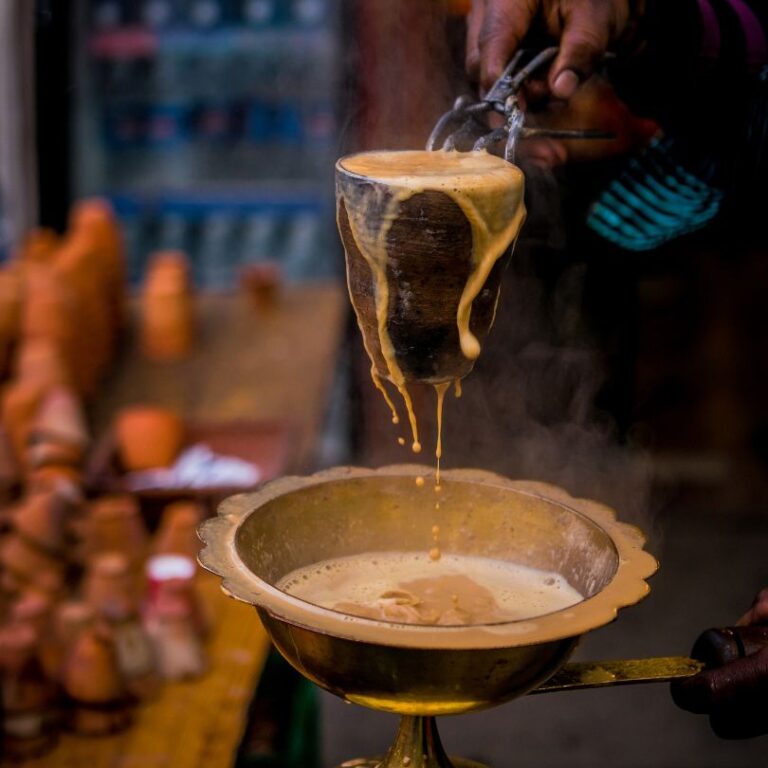
Masala Chai

When you think of Indian street food, one drink immediately comes to mind—Masala Chai. This spiced tea has become synonymous with the culture of India, offering a comforting and aromatic blend of flavours that warms both the body and soul. Masala Chai is more than just a cup of tea; it’s an experience that brings people together, whether it’s enjoyed at a roadside stall, with friends, or on a cold morning in the bustling streets of India.
This hot, spiced tea has been around for centuries, and it remains one of the most popular beverages in India, served by tea vendors, known locally as “chaiwalas.” It’s a drink that not only energizes but also embodies the essence of India’s vibrant culture and hospitality. If you’re visiting India or just want to recreate an authentic taste at home, Masala Chai is a must-try.

What is Masala Chai?
At its core, Masala Chai is black tea brewed with a variety of aromatic spices and herbs, simmered in water and milk to create a rich, creamy, and tasty drink. The spices used vary depending on the region or personal preference, but the most common ingredients include:
- Black Tea: Strong, robust black tea forms the base of Masala Chai, providing the caffeine kick.
- Spices (Masala): A blend of spices such as cardamom, cinnamon, ginger, cloves, and black pepper gives Masala Chai its distinctive warmth and complexity.
- Milk: Full-fat milk (or a combination of milk and water) adds richness and creaminess to the tea.
- Sweetener: Traditionally, sugar or jaggery is used to sweeten the tea, balancing out the bold flavours of the spices and tea.
The word “Masala” means a mixture of spices, and “Chai” simply means tea in Hindi. Together, Masala Chai refers to spiced tea, a drink that has found a place in nearly every corner of Indian society—from busy urban streets to rural villages.
The Cultural Significance of Masala Chai
Masala Chai is more than just a beverage in India; it’s a part of daily life. You’ll find chai stalls or “tapris” on almost every street in Indian cities and towns, where people gather to sip their tea and chat. Whether it’s during a work break, in the early morning, or after a long day, chai brings people together.
In fact, chai is often the first offering when you visit someone’s home. It’s a symbol of hospitality and warmth, reflecting the deep-rooted tradition of sharing tea with guests, friends, or family.
Chai is also a beloved companion to various Indian snacks like samosas, pakoras, or biscuits. The combination of spicy and sweet flavors makes it an ideal beverage to balance out the deep, savory flavors of Indian street food.
What Makes Masala Chai Unique?
What sets Masala Chai apart from regular tea is the spice blend (or “masala”) used. Each chaiwala (tea vendor) has their own unique recipe, which can change based on region or even the time of year. Here are some of the most commonly used spices that give Masala Chai its signature taste:
- Cardamom: This fragrant spice adds a subtle sweetness and aromatic quality.
- Cinnamon: Warm and comforting, cinnamon complements the richness of the tea.
- Ginger: Fresh or dried ginger provides a warming, zesty flavour and is often added during the colder months.
- Cloves: These small, pungent spices add depth and a bit of spice to the tea.
- Black Pepper: For those who like a bit of heat, black pepper gives a sharp kick that balances the sweetness of the milk and sugar.
Some recipes may also include nutmeg, fennel seeds, or star anise for added complexity. The beauty of Masala Chai lies in its versatility—each cup can be tailored to suit your taste.
The Experience of Drinking Masala Chai on the Streets
Walking through the streets of India, it’s impossible to miss the aroma of freshly brewed chai. Chaiwalas set up small stalls equipped with large pots, boiling water, milk, and tea leaves, creating a sensory experience with the sound of bubbling liquid and the smell of spices in the air. Watching them skillfully brew and pour chai into small clay cups or metal tumblers is an experience in itself.
These stalls are gathering spots for everyone—from daily commuters to students and shopkeepers. The chaiwala pours the tea with flair, often from a height to create a frothy finish, and serves it steaming hot. For many, this is a daily ritual, a moment of pause amidst the chaos of city life.
Street vendors often sell chai in small earthenware cups, known as kulhads, which are biodegradable and add a unique flavor to the tea. Drinking from a kulhad enhances the experience, providing an earthy undertone that pairs beautifully with the bold flavors of the tea and spices.
A Cup of Tradition and Flavour
Masala Chai is more than just tea—it’s a cultural tradition, a social experience, and a flavorful delight that has been cherished for generations. Whether you’re strolling through the busy streets of India or enjoying a cozy moment at home, a cup of Masala Chai provides warmth, comfort, and a taste of India’s rich culinary heritage.
.
We may receive compensation from partners listed through affiliate partnerships, at no cost to you. This doesn’t influence our ratings, and the opinions are our own
QUICK LINKS
- Blogs
- Privacy Policy
Join our Newsletter
Get the latest recipes, trends and travel ideas
